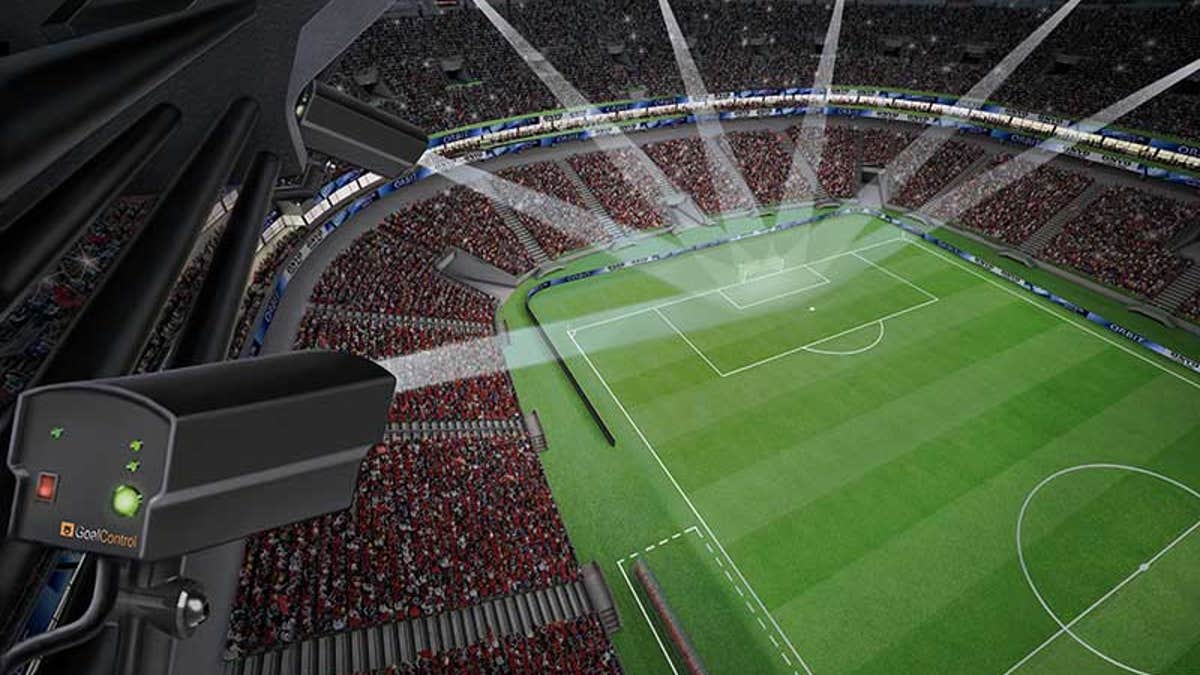
(GoalControl)
Billions of soccer fans across the globe will be cheering today when host nation Brazil kicks off against Croatia in the opening game of the World Cup. While star players such as Portugal's Cristiano Ronaldo and Brazil's Neymar will be firmly in the spotlight over the coming weeks, goal line technology (GLT) will also be grabbing plenty of attention.
For the first time, tournament organizers have turned to tech in an attempt to end the controversial goal line calls which have littered World Cup history. Up to now, referees and their two linesmen assistants have been forced to make split-second decisions about whether a goal has crossed the goal line or not, often without a clear view of the actual situation. The latest technology, however, should put an end to blown calls.
The GoalControl-4D technology uses 14 high-speed cameras operating at up to 500 frames a second to capture a three-dimensional position of the ball. Each goal has seven cameras trained on it at all times. Fixed to a high point in the stadium, such as the roof, two cameras are at the halfway line, another two are placed between halfway and the goal line and another camera is located behind the goal.
The cameras are linked via fibre-optic cable to an image processing computer that monitors the movements of every object on the pitch. Specially-built detection software is used to filter out players and the referee. Thanks to the flood of information from the cameras, the system can monitor the ball's position based on x,y and z coordinates and report its three-dimensional position anywhere on the field. Crucially for under-pressure referees, this position is monitored both when the ball is on the ground and when it’s in the air.
Within a second of the ball crossing the goal line, the system sends a message to the referee's watch, which also vibrates. The system's accurate to within a fifth of an inch, according to manufacturer GoalControl.
GoalControl spokesman Rolf Dittrich is confident that the company’s goal line technology will deliver during soccer’s showpiece, highlighting its success at two tournaments in 2013. “We have no doubts about anything,” he said. “It was perfect in the Confederations Cup last year and in the FIFA Club World Cup in Morocco in December.”
The call of “goal” or “no goal” can be a tough one for referees, particularly when the goalmouth is crowded with players or when a shot has cannoned off another part of the goal, as famously happened in the last World Cup. With England trailing Germany 2-1 in a second round game, a blistering shot from England midfielder Frank Lampard ricocheted off the crossbar and landed over the goal line before bouncing out of the goal. The referee, confused by the fierce speed of the ball and its trajectory when it bounced back into play, did not award the goal. England went on to lose the game 4-1.
Ironically, Germany was itself the victim of a controversial call in the 1966 World Cup final against England when Geoff Hurst's shot hit the underside of the crossbar and rebounded off the goal line. In that instance, however, the goal was awarded to England, although the incident remains hotly debated to this day.
Four companies initially vied to provide the coveted goal line technology for the Brazil World Cup. The sport’s governing body FIFA ultimately chose GoalControl over rivals GoalRef and Cairos Technologies whose systems required a sensor within the ball.
“The big advantage of the camera-based systems are that you don’t need modifications of the ball or the pitch,” said Dittrich.
GoalControl also beat out another camera-based system, Hawk-Eye, built by Sony-owned Hawk-Eye Innovations. With Hawk-Eye already widely-used in tennis, there were some raised eyebrows when GoalControl-4D was picked over its better-known competitor.
FIFA has not yet responded to FoxNews.com’s request for comment on this story and provided scant competitive detail last October when it announced GoalControl’s World Cup debut. The organization, however, issued a more detailed statement in April 2013 when it chose the German company over its rivals to support last summer’s Confederations Cup in Brazil, effectively a technology testing ground for the World Cup.
“The final decision was based on criteria relating more specifically to the tournaments in Brazil, including the company’s ability to adapt to local conditions and the compatibility of each GLT system in relation to FIFA match operations.” The competing bids were also judged on cost and project management factors such as staffing and time schedules for installation, according to FIFA.
The use of GoalControl-4D marks a major shift for soccer, which has typically avoided the use of on-field technology amidst fears that it will detract from the sport’s spontaneity and its continuous flow.
Dittrich, however, believes that technology will help focus fans’ attention on the most important aspect of the sport, citing a goal line controversy in the recent German cup final between Bayern Munich and Borussia Dortmund. “Nobody was talking about the game, everybody was talking about the referee,” he said.
